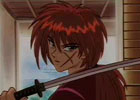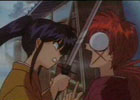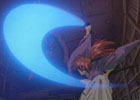Rurouni Kenshin
| Rurouni Kenshin: Meiji Kenkaku Romantan | ||
| Also Known As: RK, RuroKen, Kenshin | ||
| Genre: Action | ||
| Format: 95 Episodes | ||
| Allegiance: Shueisha | ||
| Director: Furuhashi Kazuhiro | ||
| Vintage: 1996-1998 | ||
| Intelligence Agency Report by: Kuzu Ryu Sen | ||
| At the tender age of 15, Himura Kenshin was caught up in the Bakumatsu no Doran, and became known as the Hitokiri Battousai, the most feared assassin in Japan. However, disgusted and scarred by the Revolution, Kenshin took up an oath never to kill again, and became a rurouni, wandering across Japan. Now, 10 years later, Kenshin has returned to Tokyo, a city drastically changed by Meiji rule. Can he adapt to the new age and honour his vow, or will the vengeful ghosts of the past, angered by a new era that they have no place in, prevail, and reawaken theBattousai? | ||
|
|
||
| Field Agent Report by: Kuzu Ryu Sen | ||
| Plot Characters Impact Visual Audio |
7.75 9.50 9.00 8.25 8.50 |
|
| Overall | 8.50 | |
Rurouni Kenshin could probably be best described as a Jekyll and Hyde anime. The series starts off slowly, gradually developing the feel of the series and introducing the characters, but sharply increases in quality after the first twenty or so episodes, climaxing with the fantastic Kyoto Arc. However, after the Kyoto Arc, the quality of the series decreases just as sharply, as the entire last third of the series consists of nothing but filler episodes, ending the series on a very sour note.
The opening few episodes of the series are nothing spectacular, introducing characters and consisting of several mini-arcs ranging from excellent to atrocious. Since the plot was merely average, Rurouni Kenshin relies on excellent fight sequences, and the cast of lovable characters, all with their own personalities, trademarks, and histories to hook viewers in the first dozen or so episodes. After hooking the viewer,Rurouni Kenshin refuses to release it’s grip, instead taking the audience through the gripping and powerful Kyoto Arc. Here is where the meat of the plot and character development occur, and the mood switches to a much darker tone. These changes result in a very powerful, dramatic, and moving series, while providing some truly memorable fight scenes as well. The music and seiyuu work is also top notch, and although Suzukaze Mayo’s Kenshin does take some time to get used to, once you are, you’ll never know how you lived without it.
However, good things never seem to last. With Kenshin, rather than animate the much vaunted Jinchuu Arc, the series producers decided to tack on 30 episodes worth of filler, divided into three arcs of declining quality. The tone reverts to the pre-Kyoto Arc light heartedness, and character development grinds to a halt. These changes, following the up and down emotional roller coaster that was the Kyoto Arc, turn the rest of the series into a complete let down. Worse, a lot of the characters that made the series so great do not even appear again. The only things that really justify watching the final season were a few entertaining filler episodes, and a chance to see some of your favourite personalities one more time. Still, it’s not worth money, so watch the dub on TV or borrow from a friend.
Overall, Rurouni Kenshin is still a very good series, filled with unforgettable characters and an excellent plot (for two-thirds of the series at least). While the filler episodes detract from Kenshin, the good overcomes the bad rather easily, and Kenshin has a little everything for everyone, ranging from action, to drama, to comedy, to romance. Just be careful when deciding whether to purchase the last third of the series or not.




